Tony
Morrison writes  Colonel
TE Lawrence best known as 'Lawrence of Arabia' was one of the great names in Middle
Eastern politics, adventure and literature before the Second World War. In the
late 1950s the region was again in turmoil and the name Lawrence was revived by
a stage play, Ross, in 1960 at London's Haymarket Theatre. Lawrence was
a complex person and had assumed the name Ross in 1922 when he tried to disappear
from public view. He found a place in the Royal Air Force as Aircraftsman Ross. Colonel
TE Lawrence best known as 'Lawrence of Arabia' was one of the great names in Middle
Eastern politics, adventure and literature before the Second World War. In the
late 1950s the region was again in turmoil and the name Lawrence was revived by
a stage play, Ross, in 1960 at London's Haymarket Theatre. Lawrence was
a complex person and had assumed the name Ross in 1922 when he tried to disappear
from public view. He found a place in the Royal Air Force as Aircraftsman Ross.
Virtually
parallel with the stage production of Ross, David Lean the great British
film director drew on every element of Lawrence's life to create a blockbuster
production. Released in late 1962 Lawrence of Arabia was filmed with some locations
in Jordan. The film won seven Academy awards and was the highest grossing movie
of the era. Peter
O'Toole a young actor new to cinema was given the lead and later won a Golden
Globe for his portrayal of Lawrence. I met O'Toole at a Bristol Old Vic theatre
party when I was at university in Bristol. Did I say 'plastered'?….. Peter
who at the time was the lead in many of the productions at the Theatre Royal including
William Shakespeare's Othello, held court lounging on a sofa in a student's dingy
flat in Clifton, now an upmarket part of the city, but beyond that image my memory
is hazy. In
the footsteps
Then
early in 1962 I caught up with O'Toole or at least his footsteps and a litter
of empty Scotch boxes beside an Army fort in the Jordanian desert. I was part
of a small team of four making Adventure films for BBC television. In front
of the camera we had Tom Stobart who filmed the 1953 Conquest of Everest
and Ralph Izzard who had spent his life as a correspondent with the London Daily
Mail. Ralph was our ' in house fixer' as he had lived in Beirut with his wife
Molly in the 1950s and had contacts across the Arab world. The sound recordist
and second camera was Michael Gore. I remember 'Mike' well as he was slightly
younger than me and supremely sharp witted. The
Pilgrims' Railway 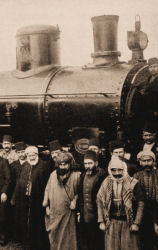 The
theme of our film was 'Lawrence' and the defunct Hijaz Railway - sometimes known
as the Pilgrims' Railway. Tom said someone had mentioned ' that there
were rumours that the wreck of a train Lawrence of Arabia had blown up near Mudawarrah
in 1918 on the Saudi Arabian border was still to be seen lying scattered in the
dust……' We were told that we could find bits of military hardware
that had not been touched so it was a ready-made BBC Adventure film story. The
theme of our film was 'Lawrence' and the defunct Hijaz Railway - sometimes known
as the Pilgrims' Railway. Tom said someone had mentioned ' that there
were rumours that the wreck of a train Lawrence of Arabia had blown up near Mudawarrah
in 1918 on the Saudi Arabian border was still to be seen lying scattered in the
dust……' We were told that we could find bits of military hardware
that had not been touched so it was a ready-made BBC Adventure film story.
In Lawrence's
time the Ottoman Empire dating from the 15th century and with even older roots
was in decline but the Turks still influenced much of the western side of the
Arabian Peninsula, now largely Saudi Arabia. The Turkish subjection of the region
with military backing from Germany and with expansionist ideas was clear even
though oil had not yet been discovered there. The only known oil deposits were
of shale oil in the Yarmouk area, now in the north of Jordan close to the Syrian
border. Lawrence
was a British Army officer working with the tribes of the Sinai (now part of Egypt)
and Palestine (larger at the time) against the Ottoman Turks and their German
supporters. Lawrence had plenty of experience as before joining the Army he had
worked on archaeological sites and mapping along the northern border of Syria.
He enjoyed the life and gained a rapport with the people. The
Arabian Peninsular was a sparsely populated wilderness of roughly 3 million sq.
kms and only wandering tribes knew the way between water holes and the few large
oases. It was not a place for the foreigner and outsiders were not welcome. Among
the most detailed early records of the interior are those of St. John Philby,
the curiously eccentric father of the master spy, Kim Philby. The best short reference
is the aptly titled and scholarly book by the late Elizabeth Monroe. St.John
Philby  St.
John Philby was a civil servant and fluent linguist, having studied modern languages
at Trinity College, Cambridge followed by another year studying Indian and Oriental
languages with a scholarship from the Indian Civil Service. He was sent from British
India to work in Basrah, Mesopotamia - now in Iraq. The Turks had been driven
out by British forces sent from India and St.John was working to help restore
order. St.
John Philby was a civil servant and fluent linguist, having studied modern languages
at Trinity College, Cambridge followed by another year studying Indian and Oriental
languages with a scholarship from the Indian Civil Service. He was sent from British
India to work in Basrah, Mesopotamia - now in Iraq. The Turks had been driven
out by British forces sent from India and St.John was working to help restore
order.
By this time in the war the British Government was looking for a way to bring
together the many Arab tribes as a united front against the Ottoman Turks, and
St.John Philby was dispatched to the middle of the Arabian Peninsula to meet Abd
al-Aziz ibn Saud, ruler of an area known as the Najd and allied with the Wahibi,
a sect of fundamentalist Muslims. The
journey St.John Philby made across the peninsula took him 44 days. Only one European
had made the crossing before him, almost 100 years earlier, in 1819, and he was
Captain Forster Sadlier of the 47th Regiment. Sent by the Government to congratulate
an Egyptian commander for his success against the Wahabis …. 'he marched
1200 miles, in European dress across every natural obstacle from Ka-tif to Yam-bu….'.
An amazing sight…. and an amazing feat. For
this journey in 1917 and another in 1918 St.John Philby was honoured in 1922 with
the Founders' Medal of the Royal Geographical Society, London, a gold medal authorised
by King George V. The
Hijaz 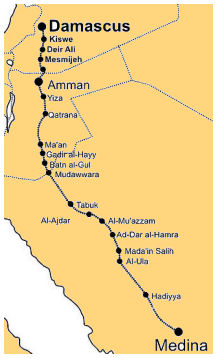 Bordering
the Red Sea the western edge of the desert peninsula is a region of about a 25,000
sq kms known as the Hijaz which was and is immensely important. The two most revered
cities of the Islamic world, Medina and Mecca, are found there. Bordering
the Red Sea the western edge of the desert peninsula is a region of about a 25,000
sq kms known as the Hijaz which was and is immensely important. The two most revered
cities of the Islamic world, Medina and Mecca, are found there.
The
Hijaz Railway from Damascus, Syria, then part of the Ottoman Empire to Medina,
some 1319 kms, was first suggested in the 19th century to replace the existing
Pilgrims' camel route through the pitiless desert. Thousands of muslims from the
Ottoman Empire made the annual hajj to Mecca along a trail with fifty-two
stops, each with a stone water cistern or well. As the camel caravans made the
way slowly the hardships were felt by some as part of the pilgrimage. Although
built largely with the aim of carrying the pilgrims, another rationale for the
line and obvious benefit for the Turks, was economic and territorial expansion.
The Hijaz Railway became a strategic supply route in the desert war and an obvious
target for Lawrence and his loosely linked tribal guerrilla force. The
Hijaz line started in Damascus where the already existing Ottoman railway running
south from Constantinople (Istanbul) on the Bosphorus - the narrow strait between
Europe and Asia - terminated. With German engineers advising, the construction
of the Hijaz Railway began in 1900 under the auspices of the Ottoman Sultan Hamid
II. A stamp tax willingly paid by the pilgrims funded the construction and by
1908 the line had reached Medina. A spur line led to Haifa on the Mediterranean
coast and opened the Yarmouk shale for German exploitation. Some of the oil was
used to fuel railway locomotives. Our
route southward We
had two Land Rovers and our route lay southward from the Jordanian capital, Amman.
Our first stop was Ma'an 195kms and once an important stop on the Hijaz line.
Beyond Ma'an the road deteriorated and the desert closed in. Colonel
F.R Maunsell, a Military Attaché in Constantinople who travelled on the
railway when it opened, wrote...
'the line enters a spirit world without towns or even inhabitants. The stages
south of Ma'an were the most desolate of all and the way was strewn with dead
or dying camels'. We
arrived at a fort in Wadi Rum 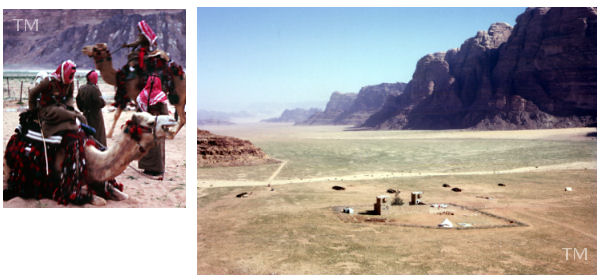 By
the time my camera rolled on Take One of my second professional television film,
the massively expensive unit shooting 'Lawrence' had moved on and the movie was
in the cutting room. Like the huge 'Lawrence' team we had the backing of King
Hussein of Jordan who provided the support of the Army's long-range Desert Patrol
- the Royal Jordanian Desert Force. This was a camel-borne elite group of Bedouin
who covered the desert end-to-end. By
the time my camera rolled on Take One of my second professional television film,
the massively expensive unit shooting 'Lawrence' had moved on and the movie was
in the cutting room. Like the huge 'Lawrence' team we had the backing of King
Hussein of Jordan who provided the support of the Army's long-range Desert Patrol
- the Royal Jordanian Desert Force. This was a camel-borne elite group of Bedouin
who covered the desert end-to-end.
Also like the Lawrence of Arabia unit we were to be based at the Desert Patrol
fort in the spectacular Wadi Rum, a land of eroded sandstone rising to 1,700m
above the desert. The
Bedouin tents for the men and their families were det up outside the compound.
Camels for daily use were kept inside and the road leading out was no more than
a dirt track that was passable in all but the worst rain. We were there in Spring
so the desert was tinged green with wonderful array of plants. But
after that, any similarity with the David Lean production ended and we faced a
remarkable journey through empty desert into the Arabian Peninsula. The asphalt
roads and land irrigated from bore-holes seen there today simply did not exist.
We continued
in our Land Rovers for a further 68kms by a clearly marked desert trail to Wadi
Rum - now a popular tourist destination. At a small Army fort in the wadi we met
the Desert Patrol who had been warned of our arrival by R/T wireless and one of
the officers guided us another 66kms through a pure arid wilderness. In
places the trail led through more eroded hills and sometimes across perfectly
flat dried mud where in rain it would have been impassable. Our final destination
was Mudawarrah then little more than a ruined Hijaz Railway station where we met
some Bedouin, the wanderers of the desert in their tents of woven goat hair. Bedouin
hospitality 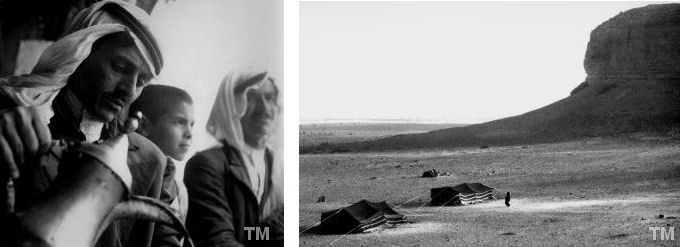 We
were welcomed royally with a mensaf a traditional dish for honoured guests,
A hand-beaten brass plate about a metre across with a shallow depression in the
centre for the food, was brought to the tent side by the Bedouin women who remained
out of sight. The men seated us on the ground with the plate on a hand woven kilim
and offered roasted lamb and a rice, with I recall had a slightly acrid flavour,
possibly from some rancid butter - samneh. Don't ask about the traditional
sheep's eyeball - luckily Tom was accustomed to the treat and scoffed it with
thanks… in Arabic. We had coffee scented with cardamum and for an hour or
more we talked with our Desert Patrol guide as interpreter. We
were welcomed royally with a mensaf a traditional dish for honoured guests,
A hand-beaten brass plate about a metre across with a shallow depression in the
centre for the food, was brought to the tent side by the Bedouin women who remained
out of sight. The men seated us on the ground with the plate on a hand woven kilim
and offered roasted lamb and a rice, with I recall had a slightly acrid flavour,
possibly from some rancid butter - samneh. Don't ask about the traditional
sheep's eyeball - luckily Tom was accustomed to the treat and scoffed it with
thanks… in Arabic. We had coffee scented with cardamum and for an hour or
more we talked with our Desert Patrol guide as interpreter.
The
children were inquisitive and played with the camera. I recall how Mike let them
hear a play-back through headphones from his small recorder. The 'ice' if any
was broken and when we heard about the wrecked line we asked to see the place
and where train wreckage had lain twisted for almost half a century. Lawrence
and his tribal guerrillas had used explosives and wrecked the train. Sand
wisped over the rails...... 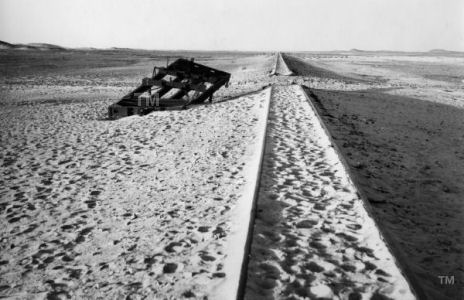 Sand
wisped over the rails and putting an ear to the metal I was sure I could hear
the clickety-clack of wheels. 'That's fantastic' said Mike and he found
a packet of cigarettes in his typically British tweed jacket. He
hailed our Bedouin helpers. Within seconds Mike had sand billowing over the line
like a miniature dust storm. Sand
wisped over the rails and putting an ear to the metal I was sure I could hear
the clickety-clack of wheels. 'That's fantastic' said Mike and he found
a packet of cigarettes in his typically British tweed jacket. He
hailed our Bedouin helpers. Within seconds Mike had sand billowing over the line
like a miniature dust storm.
We
ran some film. It was the end of the story. More
wreckage across the border The
wandering Bedouin told us that more wreckage lay in places further south including
entire locomotives, but the Saudi Arabian frontier was only another 15kms away
so Mudawarrah was our limit. But the story of the Hijaz Railway continued to flow
into our Nonesuch files for some years after the BBC filming. In 1964 The Hedjaz
Construction Company Ltd, based in London headed a plan to rebuild sections of
the line and Press coverage ran for some months. 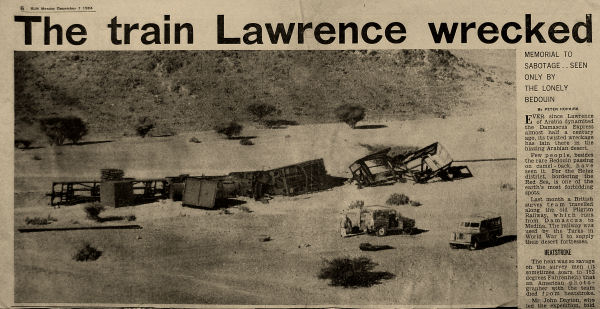 Peter
Hopkirk Peter
Hopkirk
Peter
Hopkirk a journalist and author who went on to specialise in Middle Eastern and
Central Asian stories wrote a piece for the London Sun newspaper in December 1964.
He described a survey team working along the line - 'the desert heat was so
intense a photographer died of heat stroke - he just sank suddenly to his knees
-dead.' They found wrecked engines and bridges and 'They stumbled upon
a British Army fused gun-cotton pack left by the saboteurs 47 years ago.'
(gun-cotton = an explosive propellant used in artillery shells). The
Hijaz Railway was rebuilt in some sections but not for the entire length. Some
of the old locomotives were restored to working order and others are in museums.
Parts still lie in the desert. l. But
a final thought. When we were there in 1962 we heard that the broken line we saw
in Mudawarrah may have been wrecked, not by Lawrence, but by Major Robin Buxton,
a military commander in the Imperial Camel Corps and friend of Lawrence. I have
a note in my diary and apparently it could be true. Our
film narrated by Tom kept to the Lawrence tale and received some glowing comments
- 'the ceremonial hospitality of a Bedouin camp' 'a finely photographed piece'
' there's nothing like a camel train in semi-silhouette to stir the imagination.'
As journalists say 'Don't let the facts get in the way….' Epilogue Changes
- Mudawarrah is still there with numerous green patches for agriculture irrigated
from bore holes. The Bedouin have settled to tend the crops. A road runs south
to a customs post at the Saudi Arabian frontier. The old railway track has gone
leaving just the firm bed on which it ran. Most
recently
in 2012, some remains left by Lawrence and his Arab guerrilas have been investigated
by a team from the University of Bristol. The research project led by Professor
Nicholas Saunders has been named GARP - the Great Arab Revolt Project and has
been widely covered in the British Press and specialist magazines. It seems that
the Lawrence story is alive and well. T
E Lawrence
died from injuries received in a motor-cycle accident in England in 1935. His
name will be linked forever with the Arab Revolt of 1916 - 1918 by academics and
politicians. And, Lawrence's name will be remembered by many people thanks to
the David Lean film. Lawrence received military honours for his desert exploits
and the award of the Companion of the Order of the Bath, a British Order of Chivalry
dating back to 1735. Apparently he refused a Knighthood. Seven
Pillars of Wisdom is a mammoth book Lawrence wrote about his experiences and
has become a classic of the era. Various editions are known and some are rarely
seen. Revolt in the Desert is a shorter, popular edition of his work. St.
John Philby
died in 1960 and is buried in the Muslim cemetery in Beirut. He had converted
to Islam, His name and achievements tend to be overlooked because of his background
and opinions - also not to be forgotten is the legacy of his son Kim. The Times
of London published a long obituary with a photograph but failed to mention his
Royal Geographical Society award, his only official recognition in Britain. The
Empty Quarter
- more epic journeys The Rub' al Khali, also known
as the Empty Quarter, in the southeast of the Arabian Peninsular is the most arid
part and regarded as the world's largest unbroken desert. The first recorded journeys
there were in 1931 by Bertram Thomas a British Civil Servant, and in 1932 by St.John
Philby. Wilfred Thesiger whose name in the public mind is most often linked to
the Empty Quarter arrived more than ten years later to be welcomed by St. John
Philby.
St.John's story is told in his many books. A large number of his private papers
are kept in the Middle East archives of St. Antony's College, Oxford, England
Peter
O'Toole
died in 2013 with many film and stage awards. He wrote two books and his life
story is covered by literally hundreds of Press stories and reviews Peter
Hopkirk died in 2014. He had written six books, of which, perhaps,
The Great Game -1992 was best known - it covered the struggle for Empire
in Central Asia. In 1992 Peter was awarded the Sir Percy Sykes Memorial Medal
by the Royal Society for Asian Affairs.
|